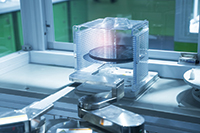
Posted to News on 31st Jul 2020, 00:00
Improving reliability in harsh applications
Barney Eley, Senior Application Engineer at The Barden Corporation, and Stefan Vogel, Sales and Applications Manager AT HQW Precision discuss how bearings take the pressure and handle the heat in the harshest applications.

Throughout industry there is increased demand to improve operational efficiencies and reliability as companies look to protect their bottom lines. One crucial part of machines that needs to be considered are the bearings systems as their design has a fundamental effect on the reliability of a machine, especially in extreme operating environments.
Applications in a vacuum, at high or low temperatures, or a corrosive atmosphere for example, cause issues for standard bearings and they are prone to premature failure. A bearing system comprises many elements including balls, rings and cages and to improve reliability in these conditions, each part needs to be carefully reviewed.
Operating in a vacuum
In ultra-high vacuum environments such as those that are present in manufacturing electronics, semiconductors and LCDs, the pressure can be lower than 10-7mbar. Ultra-high vacuum bearings are typically used in actuation equipment within in the manufacturing environment. Another typical vacuum application is turbomolecular pumps (TMP) which generate the vacuum for manufacturing environments. In this latter application the bearings are often required to work at high speed.
Lubrication: Lubrication in these conditions is key. At such high vacuums, standard lubrication greases evaporate and also outgas, and the lack of effective lubrication can result in bearing failure. Special lubrication therefore needs to be used. For high vacuum environments (down to approximately 10-7 mbar) Perfluoropolyether (PFPE) greases can be used as they have a much higher resistance to evaporation. For ultra-high vacuum environments (10-9 mbar and below) solid lubricants and coatings need to be used.
For medium vacuum environments (around 10-2 mbar), with careful design and selection of special vacuum grease, bearing systems that deliver long life times of more than 40,000 hours (approximately 5 years) of continual use, and operate at high speeds, can be achieved.
Handling low temperatures
Lubrication: For example, in cryogenic pumping applications with temperatures in the region of -190°C, oil lubrications become waxy resulting in bearing failure. Solid lubrication such as molybdenum disulphide (MOS2) or tungsten disulphide (WS2) is ideal for improving reliability. Furthermore, in these applications, the media being pumped can act as the lubricant, so the bearings need to be specially configured to operate at these low temperatures using materials that work well with the media.
Materials: One material that can be used to improve a bearing’s fatigue life and wear resistance is SV30 – a martensitic through-hardened, high nitrogen, corrosion-resistant steel. Ceramic balls are also recommended as they deliver superior performance. The inherent mechanical properties of the material mean they provide excellent operation in poor lubrication conditions, and it is far better suited to operate reliably at low temperatures. Cage material should also be chosen to be as wear resistant as possible. Good options here include Polyether-ether-ketone (PEEK), Polychlorotrifluoroethylene (PCTFE) and Polyamide-imide (PAI) plastics.
Heat treatment: Rings should be specially heat treated to improve dimensional stability at low temperatures.
Internal design: A further consideration for working in low temperatures is the bearing’s internal design. Bearings are designed with a level of radial play, but as temperature reduces, the bearing components undergo thermal contraction and the amount of radial play is therefore reduced. If the level of radial play reduces to zero during operation this will result in bearing failure. Bearings that are intended for low temperature applications should be designed with more radial play at room temperatures to allow for an acceptable level of operating radial play at low temperatures.
Reliability at high temperatures
At the other end of the scale, high temperature applications, such as those used in actuation systems within the aerospace industry can present challenges for standard bearings. Furthermore, temperatures are rising in equipment as units become increasingly smaller and have increased power-density.
Lubrication: This is an important consideration. Oils and greases have maximum operating temperatures at which point they will start to degrade and evaporate quickly leading to bearing failure. Standard greases are often limited to a maximum temperature of around 120°C and some conventional high temperature greases are capable of resisting temperatures of up to 180°C.
However, for applications that require even higher temperatures special fluorinated lubricating greases are available and temperatures in excess of 250°C are attainable. Where liquid lubrication is not possible, solid lubrication is an option which allows for low speed reliable operation at even higher temperatures. In this case MOS2, WS2, graphite or Polytetrafluoroethylene (PTFE) are recommended as solid lubricants as they can tolerate very high temperatures for longer periods of time.
Materials: When it comes to temperatures in excess of 300°C special ring and ball materials are necessary. AISI M50 is a high temperature steel that is typically recommended as it exhibits high wear and fatigue resistance at high temperatures. BG42 is another high temperature steel that has a good hot hardness at 300°C and is commonly specified since it has high levels of corrosion resistance and is also less susceptible to fatigue and wear at extreme temperatures.
High temperature cages are also required and they can be supplied in special polymer materials including PTFE, Polyimide, PAI and PEEK. For high temperature oil lubricated systems bearing cages can also be manufactured from bronze, brass or silver-plated steel.
Coatings and heat treatment: Advanced coatings and surface treatments can be applied to bearings to combat friction, prevent corrosion and reduce wear, thus improving the bearing performance at high temperatures. For example, steel cages can be coated with silver to improve performance and reliability. In the case of lubricant failure/starvation, the silver-plating acts like a solid lubricant, allowing the bearing to continue running for a short period of time or in an emergency situation.
Corrosion resistance
Bearings which are intended for use in a corrosive environment need to be specially configured as they can potentially be exposed to acids, alkalis and salt water among other corrosive chemicals.
Materials: Materials are a vital consideration for corrosive environments. Standard bearing steels readily corrode, leading to early bearing failure. In this case, SV30 ring material with ceramic balls should be considered as they are highly resistant to corrosion. In fact, studies have shown that SV30 material can last many times longer than other corrosion resistant steel in a salt spray environment. In controlled salt-spray tests SV30 steel only shows slight signs of corrosion after 1,000 hours (see graph 1) and SV30’s high corrosion resistance is clearly seen on the test rings. Special ceramic ball materials such as Zirconia and Silicon Carbide can also be used to further increase a bearing’s resistance to corrosive substances.







